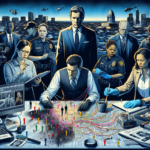High-profile trials have always captured the attention of the public due to their dramatic and often shocking nature. These trials not only showcase the legal system in action but also provide insight into human behavior, motives, and the pursuit of justice. When a high-profile trial invades national headlines, it can spark intense debates, emotions, and discussions among the general public.
The Trial Begins
High-profile trials typically begin with a pre-trial phase where the evidence is gathered, witnesses are interviewed, and the legal strategy is formulated. The prosecution and defense teams work tirelessly to build their cases, relying on forensic experts, investigators, and legal scholars to uncover the truth.
Once the trial officially begins, the courtroom becomes a stage for passionate arguments, emotional testimonies, and compelling evidence presentations. The media plays a crucial role in covering the trial, providing live updates, analysis, and commentary to the public. This continuous coverage ensures that the trial remains in the national spotlight, drawing in viewers and readers from around the country.
The Key Players
In every high-profile trial, there are key players who dominate the narrative and capture the public’s attention. The defendant, the victim, the judge, the prosecutors, and the defense attorneys all play critical roles in shaping the outcome of the trial. Each individual brings their own unique perspective, motivations, and biases to the courtroom, creating a complex and dynamic legal landscape.
The defendant is often portrayed as the central figure in the trial, as their actions or alleged crimes are the focus of the legal proceedings. The victim, on the other hand, is a symbol of innocence and vulnerability, their story serving as a powerful emotional appeal to the jurors and the public. The judge must maintain order in the courtroom, ensuring that the trial proceeds fairly and impartially. The prosecutors and defense attorneys engage in a battle of wits and strategies, using every legal tool at their disposal to secure a favorable outcome for their respective sides.
The Drama Unfolds
High-profile trials are a breeding ground for drama, intrigue, and suspense. The courtroom becomes a theater of emotions, as witnesses break down in tears, defendants proclaim their innocence, and lawyers deliver fiery speeches to the jury. Every twist and turn in the trial adds to the tension and excitement, keeping the audience on the edge of their seats.
One of the most riveting aspects of a high-profile trial is the cross-examination of witnesses. Defense attorneys and prosecutors use this opportunity to challenge the credibility of the opposing side’s witnesses, exposing inconsistencies, biases, and ulterior motives. These intense showdowns can make or break a case, as the jury carefully weighs the testimonies and evidence presented before them.
The Verdict
After weeks or even months of proceedings, the trial finally reaches its climax with the delivery of the verdict. The tension in the courtroom is palpable as the jury foreperson announces the defendant’s fate – guilty or not guilty. The reaction of the defendant, the victim’s family, and the legal teams is often emotional and raw, reflecting the gravity of the moment.
Once the verdict is rendered, the media frenzy surrounding the trial reaches its peak. Headlines blare the outcome, pundits analyze the implications, and the public reacts with a mix of relief, satisfaction, or outrage. The legacy of the trial – whether it be a landmark verdict, a miscarriage of justice, or a significant cultural moment – lingers long after the courtroom doors have closed.
Conclusion
High-profile trials have a unique ability to captivate and divide the public, shining a spotlight on the complexities of the legal system and the human condition. As these trials invade national headlines, they become more than just legal proceedings – they become cultural touchstones, sparking conversations, debates, and reflections on justice, morality, and the power of the law.



